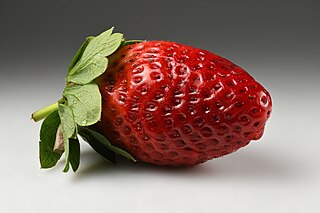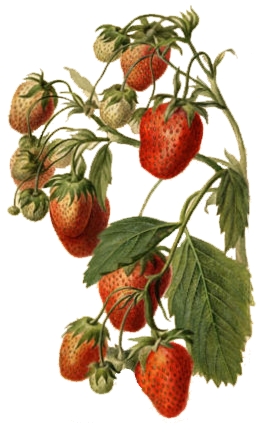
A berry is a small, pulpy, and often edible fruit. Typically, berries are juicy, rounded, brightly colored, sweet, sour or tart, and do not have a stone or pit, although many pips or seeds may be present. Common examples of berries in the culinary sense are strawberries, raspberries, blueberries, blackberries, white currants, blackcurrants, and redcurrants. In Britain, soft fruit is a horticultural term for such fruits.

Fragaria is a genus of flowering plants in the rose family, Rosaceae, commonly known as strawberries for their edible fruits. There are more than 20 described species and many hybrids and cultivars. The most common strawberries grown commercially are cultivars of the garden strawberry, a hybrid known as Fragaria × ananassa. Strawberries have a taste that varies by cultivar, and ranges from quite sweet to rather tart. Strawberries are an important commercial fruit crop, widely grown in all temperate regions of the world.

The garden strawberry is a widely grown hybrid species of the genus Fragaria in the rose family, Rosaceae, collectively known as the strawberries, which are cultivated worldwide for their fruit. This is appreciated for its aroma, bright red colour, juicy texture, and sweetness. It is eaten either fresh or in prepared foods such as jam, juice, pies, ice cream, milkshakes, and chocolates. Artificial strawberry flavourings and aromas are widely used in commercial products. Botanically, the strawberry is not a berry but an aggregate accessory fruit; each apparent 'seed' on the outside of the strawberry is actually an achene, a botanical fruit with a seed inside it.

Fragaria virginiana, known as Virginia strawberry, wild strawberry, common strawberry, or mountain strawberry, is a North American strawberry that grows across much of the United States and southern Canada. It is one of the two species of wild strawberry that were hybridized to create the modern domesticated garden strawberry.

The musk strawberry or hautbois strawberry, is a species of strawberry native to Europe. Its French name hautbois strawberry may be anglicised as hautboy strawberry. The plants are hardy and can survive in many weather conditions. They are cultivated commercially on a small scale, particularly in Italy. The fruit are small and round; they are used in the gourmet community for their intense aroma and flavour, which has been compared to a mixture of regular strawberry, raspberry and pineapple. Popular cultivated varieties include 'Capron' and 'Profumata di Tortona'.

Fragaria vesca, commonly called the wild strawberry, woodland strawberry, Alpine strawberry, Carpathian strawberry or European strawberry, is a perennial herbaceous plant in the rose family that grows naturally throughout much of the Northern Hemisphere, and that produces edible fruits.

Fragaria × vescana is a hybrid strawberry cultivar that was created in an effort to combine the best traits of the garden strawberry, which has large berries and vigorous plants, with the woodland strawberry, which has an exquisite flavour, but small berries. Plants of the World Online considers it an unplaced taxon – "names that cannot be accepted, nor can they be put into synonymy."

Fragaria chiloensis, the beach strawberry, Chilean strawberry, or coastal strawberry, is one of two species of wild strawberry that were hybridized to create the modern garden strawberry. It is native to the Pacific Ocean coasts of North and South America.

Fragaria viridis, commonly called creamy strawberry or green strawberry is a species of strawberry native to Europe and central Asia. It has fruits with fine flavour. They have surprisingly little of the usual strawberry aroma, but a refreshing acidity, and sometimes ripen without becoming red. When they are plucked from the plant, the calyx will usually adhere and they will detach with a noticeable snapping sound.

Fragaria nilgerrensis is a species of flowering plant in the family Rosaceae. It is a wild strawberry native to southern and southeast Asia. It is similar in appearance to F. moupinensis. Its fruit are white to light pink, with flavour reminiscent of peach, and the fruit is of no commercial value.
Xanthomonas fragariae is a species of bacteria. It causes a leaf spot disease found in strawberries. The type strain is NCPPB1469 from Fragaria chiloensis var. ananassa.

The Marshall strawberry is a cultivated variety of Fragaria ananassa, that is known for an "exceptional" taste and had been described as "the finest eating strawberry" in America.
Strawberry crinkle cytorhabdovirus, commonly called Strawberry crinkle virus (SCV), is a negative sense single stranded RNA virus that threatens strawberry production worldwide. This virus reduces plant rigidity, runner production, fruit size, and production, while causing distortion and crinkling of the leaves. This virus was first described in 1932 in Oregon and California with commercial strawberry varieties, and later became an issue around the world, including North America, South America, Europe, South Africa, New Zealand, Australia, and Japan. Of the family Rhabdoviridae, it is a large family of viruses that affects plants, vertebrates, and invertebrates. Specifically, this virus infects strawberry plants of the genus Fragaria and is transmitted through two aphid vectors that feed on strawberries, Chaetosiphon fragaefolii and C. jacobi. When SCV is combined with other aphid-transmitted strawberry viruses, such as mottle, mild yellow-edge, vein banding, or pallidosis, the damage becomes even more deleterious. Economically, the only significant host of SCV is Fragaria ananassa.
Strawberry mild yellow-edge virus (SMYEV) is a pathogenic plant virus.
Fragaria × bringhurstii is a naturally occurring hybrid species of wild strawberry native to the West Coast of the United States. The species results from the natural intercrossing of Fragaria vesca and Fragaria chiloensis, native species whose ranges overlap in that region.

Pineberry is a white strawberry cultivar with red seeds and a pineapple-like flavor.
Fragaria pentaphylla is a tetraploid species of wild strawberry native to China. In Chinese, it is called the "five-leaf strawberry".

The following outline is provided as an overview of and topical guide to strawberries:

Strawberries in the United States are almost entirely grown in California – 86% of fresh and 98% of frozen in 2017 – with Florida a distant second. Of that 30.0% was from Monterey, 28.6% from Ventura, 20.0% from Santa Barbara, 10.0% from San Luis Obispo, and 9.2% from Santa Cruz. The Watsonville/Salinas strawberry zone in Santa Cruz/Monterey, and the Oxnard zone in Ventura, contribute heavily to those concentrations.















